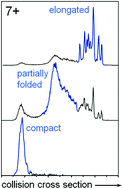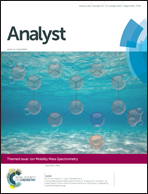Microheterogeneity within conformational states of ubiquitin revealed by high resolution trapped ion mobility spectrometry
Abstract
The present work employs trapped ion mobility spectrometry (TIMS) for the analysis of ubiquitin ions known to display a multitude of previously unresolved interchangeable conformations upon electrospray ionization. The conformational distributions of ubiquitin [M + 6H]6+ through [M + 13H]13+ ions observed by TIMS are nearly identical to numerous drift tube ion mobility spectrometry studies reported in the literature. At an experimental resolving power up to ∼300, many of the congested conformations within the well-known compact, partially folded, and elongated [M + 7H]7+ states are separated. Minimizing the voltages (RF and DC) in the entrance funnel results in exclusive observation of compact [M + 7H]7+ conformers. However, under these conditions, the mobility-dependent pseudopotential coefficient may discriminate against ions having larger collision cross sections—a universal effect for all RF ion guides, funnels, and traps operating in the presence of a gas. The data presented underscore the complications associated with direct comparison of collision cross section values that represent an ensemble average of multiple underlying conformations. As illustrated herein, the microheterogeneity within a particular conformational family and the relative state-to-state abundance can be altered by solvent memory, energetic, and kinetic effects.

- This article is part of the themed collection: Ion Mobility Mass Spectrometry

 Please wait while we load your content...
Please wait while we load your content...